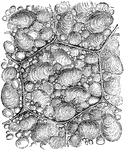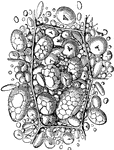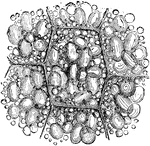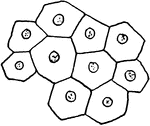
Mucous Membrane
Section of mucous membrane of the small intestine. One the left a villus is seen in seen in section.…
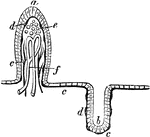
Mucous Membrane
Section of mucous membrane of the small intestine. One the left a villus is seen in seen in section.…

Bonellia Viridis (Male)
Illustration of a male green spoonworm. A, Generative pore with spermatozoa; B, Anterior blind end of…

Diseased Leaf
"Transverse section of a diseased patch in the leaf showing the hyphae of the fungus pushing between…
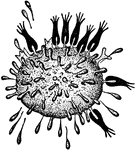
Cytolysis, Stage 1
"Ehrlich's diagrams illustrating the mechanism of immunity and cytolysis. The figures in black indicate…
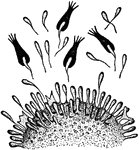
Cytolysis, Stage 2
"Ehrlich's diagrams illustrating the mechanism of immunity and cytolysis. The figures in black indicate…
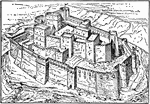
Krak des Chevaliers
Krak des Chevaliers was the headquarters of the Knights Hospitaller during the Crusades. It was expanded…

Sectional View of Acanthobdella
An illustration of a sectional view of a Acanthobdella, a member of the annelid family. "c, Coelom;…
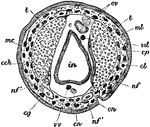
Sectional View of Acanthobdella
An illustration of a sectional view of a Acanthobdella, a member of the annelid family. "c, Coelom;…

Noctilucales
An illustration of Noticulales with buds. The Noctilucales are a peculiar order of marine dinoflagellates.…
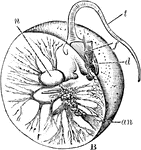
Noctilucales
An illustration of Noticulales in section: an, anus; d, denticle; f, flagellum; t, tentacle. The Noctilucales…

Noctilucales
The Noctilucales are a peculiar order of marine dinoflagellates. They differ from most others in that…

Modern Pipe-Spout Pot
This modern pipe-spout pot is a tea-kettle. It is made out of metal and has a hoop handle with a wooden…
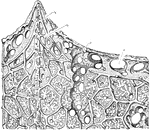
Upper Section of Sponge
An illustration of the upper portion of a sponge: p, Pore; s, Subdermal cavity; c1, chief fiver of the…
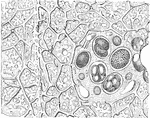
Lower Section of Sponge
An illustration of the lower portion of a sponge. O, OS, and M are illustrations of sponge eggs magnified…

Medusa of a Hydroid
Colonial, plant-like animals closely related to jellyfish, with stinging cells, Any member of the invertebrate…
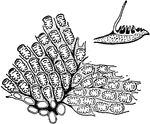
Bryozoan
A modern Bryozoan, a group of cells or zooecia seen from above, and a single cell seen from the side.

Cuttlebone
Cuttlefish "bone" or internal shell. The fine point at the base structure represents the guard of the…
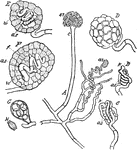
Eurotium Fungus
"Eurotium repens. A, a small portion of the mycelium with a conidiophore (c), terminated by the sterigmata…
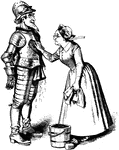
Woman Washing a Man in Armor
An illustration of a man wearing a suit of armor with a woman washing it.
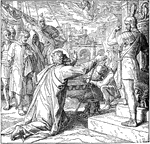
St. Paul's Arrival at Rome in Chains
"And when we came to Rome, the centurion delivered the prisoners to the captain of the guard: but Paul…
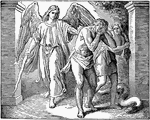
Adam and Eve Driven out of the Garden of Eden
"Therefore the LORD God sent him forth from the garden of Eden, to till the ground from whence he was…
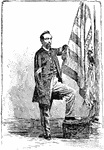
Sergeant Thomas Plunkett
Private Thomas Plunkett (1841 - 1885) was a color bearer during the Civil War. He carried the banner…
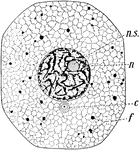
Typical amimal cell
A typical cell consists of two portions, one, te firmer, forming an excessively delicate meshwork enclosing…
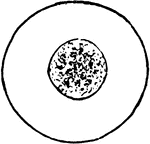
Blood cell
Blood cell function is to transport nutrients and oxygen to the cells; wastes and carbon dioxide to…
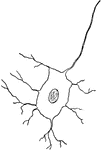
Nerve Cell
Animal nerve cells are specialized cells called neurons. Figure 1C is a nerve cell with parts of its…
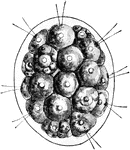
Pandorina
Pandorina, a one-celled, fresh water form, is a genus of green algae composed of 8, 16, or sometimes…
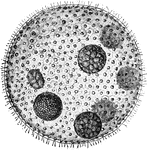
Volvox
Volvox is one of the best-known chlorophytes, a division of green algae, and is the most developed in…
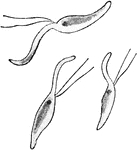
Volvox
Under certain circumstances some cells may store up food matters beome eggs, while others, known as…
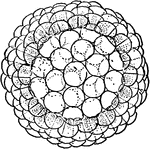
Sponge Develoment
The sponge, a many celled animal, begins its life as a single-cell, the egg. The continued division…
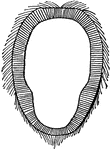
Sponge Develoment
The sponge, a many celled animal, that begins its life as a single-cell, the egg. The continued division…

Sponge Develoment
The sponge, a many celled animal, begins its life as a single-cell, the egg. After division of cells…

Skeleton of Sponge
In zoology a skeleton is any fairly rigid structure of an animal, irrespective of whether it has joints…
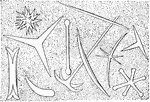
Sponge Spicules
Spicules may be made of silica or calcium carbonate, and vary in shape from simple rods to three-dimensional…

Hydra Jellyfish
Fresh water Hydra, a jellyfish, is a many celled animal. Shown is a Hydra nettle cells.

Hydra Jellyfish
Fresh water Hydra, a jellyfish, is a many celled animal. The organs of defence, nettle cells or lasso…
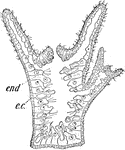
Hydra Jellyfish
Fresh water Hydra, a jellyfish, is a many celled animal. The organs of defence, nettle cells or lasso…
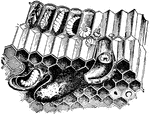
Honey Bees
Bees are flying insects closely related to wasps and ants. Honey bees (or honeybees) are a subset of…
Carpenter Bee
Carpenter bees are large, hairy bees distributed worldwide. Their name comes from the fact that nearly…
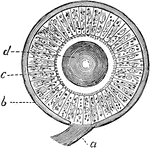
Sense of Hearing
Hearing is the perception of certain vibrations of bodies. These vibrations give rise to sound waves.…
Parts of the Gun
"Gun. A, breech; B, barrel; C, band; D, breech-block; E, butt; F, butt- or heel-plate; G, front sight…

Field Gun Carriage
"Field-gun Carriage. A, stock. B, cheek. a, lunette; b, trail-plate; c, c, pointing-rings; d, handle;…
Pole Screen
The pole screen is a small screen that is supported on a tall slender poll with a tripod (three legged)…
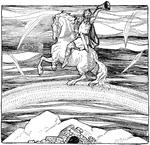
Heimdall Warns the Gods
In Norse mythology, Heimdall is the guardian of the gods. When Loki causes evil spirit to be in everyone,…

Liverwort Life Cycle
"Life-history of Liverwort (Marchantia polymorpha): 1 and 2, developing thallus; 2 shows the cup with…
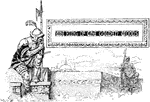
Guard Sitting Looking Over Ledge Pictorial Banner
A pictorial banner illustrated with a guard leaning on a ledge looking over the city.

Mantle
An illustration of a mantle, a type of loose garment usually worn over indoor clothing to serve the…
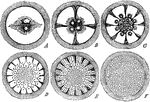
The Segmentation of the Vitellus
"The first change in the parent-cell is that by which it becomes broken up into a mass of cells, each…
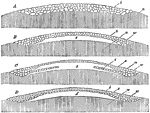
Egg Germination
"Further development of hen's egg; after Haeckel: A, the mulberry mass of cleavage cells, b, same as…
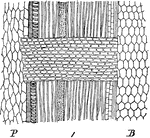
Medullary Rays of Maple
"Longitudinal radial section through the wood of a branch of maple one year old: P, pith; B, bark."…
The Respiratory and Vocal Organs of a Rook
"Resipratory and vocal organs of the Rook, Corvus frugilegusm an Oscine Passerine bird; 1 a, tongue;…
